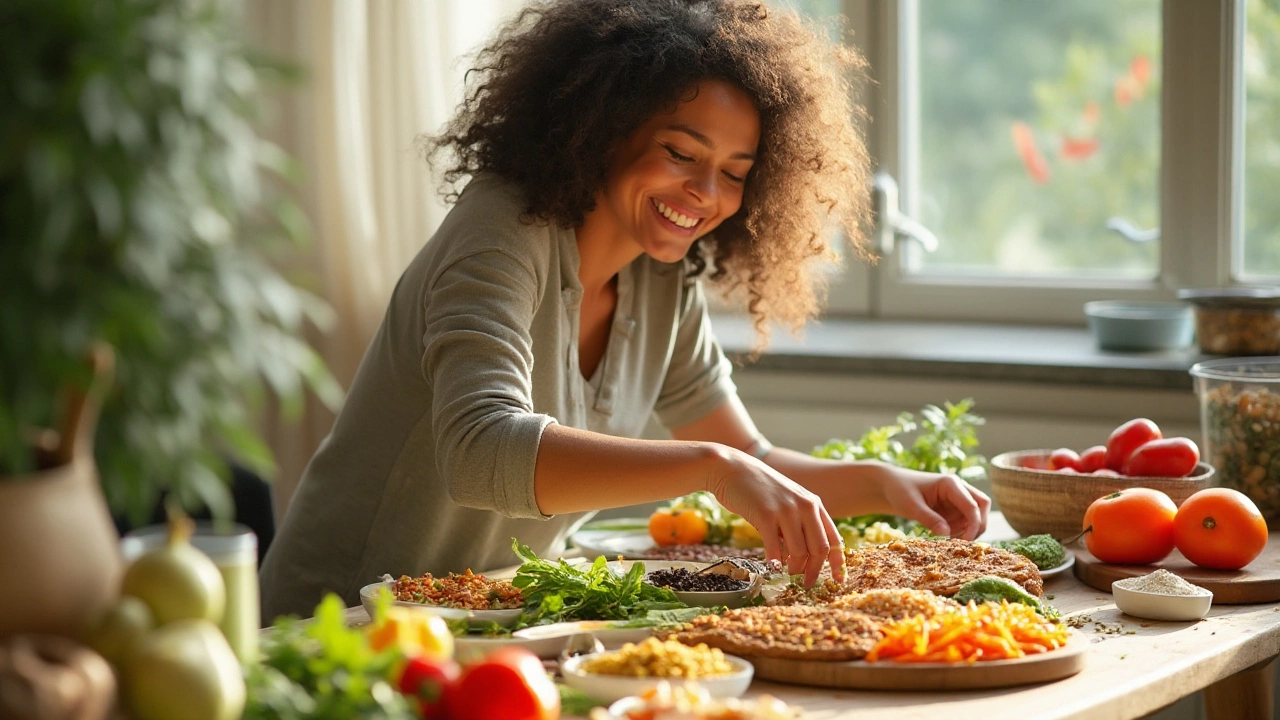Diving into the vegan lifestyle opens the door to a world of flavorful and nutritious eating, all while aligning with your weight loss ambitions. While the plant-based approach focuses heavily on consuming foods that are rich in natural goodness, a bit of strategy can enhance its effectiveness in shedding pounds. With the right blend of ingredients, you can enjoy meals that both satisfy and support your health goals.
Contrary to common belief, transitioning to a vegan diet does not mean compromising on the protein needed for muscle maintenance and growth. On the contrary, there are plenty of plant-based proteins to incorporate into your daily meals. Next up, discover which grains can keep hunger at bay, and how the right fats can play a surprising role in staying fit.
In this guide, we'll also emphasize the importance of mindfully enjoying every bite. Exploring new recipes and making small changes can add up to big results. Let's unravel the essential ingredients and practices that make veganism a sustainable choice for weight loss.
- The Role of Protein in a Vegan Diet
- Wholesome Grains to Keep You Satiated
- Healthy Fats for Vegans
- Mindful Eating and Portion Control
The Role of Protein in a Vegan Diet
Protein is often hailed as the cornerstone of any well-balanced diet, and this holds especially true when pursuing weight loss. Once regarded as a challenging aspect for those choosing a vegan diet, protein has become much easier to incorporate thanks to the diverse array of plant-based sources available. From lentils and chickpeas to tofu and tempeh, these options not only satisfy your protein needs but also offer a range of delicious flavors and textures that can elevate any dish. It’s a myth that vegans have limited options, and the bounty of protein-rich plants dispels that myth entirely. The versatility and nutrient density of these foods make them ideal staples in any vegan pantry.
Diving into the specifics, legumes such as beans and lentils are powerhouse foods not to be overlooked. For instance, a cup of cooked lentils offers about 18 grams of protein, along with a hearty dose of dietary fiber that promotes satiety, assisting in weight loss efforts. Including them in soups, stews, or salads not only enriches your meals but also ensures you're meeting your protein targets. Another protein gem is quinoa, a grain that packs around 8 grams of protein per cup and is a source of all nine essential amino acids. Its versatility makes it a perfect base for various dishes, be it a chilled salad or a warm pilaf.
For soy enthusiasts, tofu and tempeh present exciting avenues for culinary exploration. These soy products often serve as the main protein in countless vegan recipes, offering about 20 grams of protein per cup in tofu alone. For those worried about the potential monotony, fear not; both tofu and tempeh absorb flavors brilliantly and can be marinated, grilled, stir-fried, or even baked. Add to that the great value of these soy products in terms of calcium and iron content, making them even more essential for a holistic diet.
"A well-planned vegan diet rich in protein can power athletes and support muscle build-up," says renowned dietitian Brenda Davis. "The variety of plant-based proteins available today offers a wide spectrum of choices that are both healthful and delicious," she emphasizes.
Nuts and seeds such as almonds, hemp seeds, and chia seeds also deserve attention when discussing plant-based protein. Integrating nuts into meals or enjoying them as snacks can effortlessly enhance protein intake—a serving of almonds, for example, provides about 6 grams of protein. Hemp seeds, in smaller quantities, amplify any meal's protein content and offer essential omega-3 fatty acids. These easy-to-incorporate foods can boost a vegan diet's protein profile while enriching it with essential fats.
Rounding off the list are protein-packed vegetables like spinach, broccoli, and Brussels sprouts. While they may not rival legumes and grains in pure protein numbers, they contribute significantly when combined with other food groups, adding to the overall protein tally of each meal. By conscientiously balancing your meal plan with these varied and vibrant ingredients, achieving your protein goals becomes not only attainable but enjoyable. With a thoughtful approach and a dash of culinary creativity, building a protein-rich vegan diet that supports weight loss is well within reach, proving both nutritious and palate-pleasing.

Wholesome Grains to Keep You Satiated
Embarking on a plant-based journey does not imply shunning all things carb-related. In fact, the right grains can be foundational to maintaining energy and fullness throughout the day. For those leaning into a vegan lifestyle, wholesome grains are an invaluable ally in the quest for achieving and maintaining weight loss. Their abundance of fiber, vitamins, and minerals work collectively to create a health-enhancing effect that goes beyond simple calorie counting. Imagine starting your day with a hearty bowl of oats. Whole grains like oats are known to stabilize blood sugar levels, which in turn helps protect against hunger pangs. This means you can walk past the mid-morning pastry tray without a second thought, knowing you've fueled your body with something much more beneficial.
Quinoa, often hailed as a superfood, packs a punch with its high protein content - a rare trait among grains. It's not just the protein; quinoa is also rich in essential amino acids, making it ideal for building a complete and nourishing meal. As if that weren't enough, its versatility makes it a favorite in salads, bowls, and even as a breakfast option when combined with fruits and nuts. It's a small change that can yield significant gains in one’s daily dietary routine. Did you know that by adding quinoa to your meals, you can meet 15% of your daily iron needs in a mere cup?
“Americans who eat whole grains tend to have a lower body mass index (BMI) than those who eat fewer whole grains,” says the Whole Grains Council.
To diversify the culinary landscape further, let's not forget about the less famous but equally impressive barley and freekeh. Barley is teeming with soluble fiber, which not only satiates but also contributes to healthy cholesterol levels. It’s the kind of grain that works beautifully in soups or as a substitute for rice, providing a nutty flavor that's hard to resist. Meanwhile, freekeh, which is young green wheat, boasts a low glycemic index, making it another excellent choice for those looking to avoid energy spikes that often lead to overeating. Incorporating these into your vegan recipes can bring about a substantial shift towards more mindful eating habits.
A noteworthy pointer for anyone embracing these grains is their beneficial impact on gut health. The mix of prebiotics found in whole grains supports the growth of beneficial bacteria in the intestines, which is synonymous with enhanced digestion and nutrient absorption. When the gut is healthy, the entire body functions more smoothly, which can even contribute to mental clarity and improved mood. By choosing the right grains, you are effectively setting yourself up for a system overhaul that aids not just in weight loss but in fostering a balanced, vibrant life.

Healthy Fats for Vegans
For those pursuing a vegan diet while seeking to lose weight, understanding the role of healthy fats is crucial. While fats have often been misaligned as the villains in the diet world, it's essential to differentiate between the harmful and beneficial types. Recognizing the good ones can provide the body with energy, support cell growth, and help in absorbing vital nutrients. When integrated thoughtfully into a plant-based regime, healthy fats can keep you satisfied without adding unwanted pounds. Avocados, nuts, and seeds, such as chia and flaxseeds, are excellent sources of these beneficial fats. Not only do they enrich your meals with flavors, but they also come packed with omega-3 and omega-6 fatty acids. Studies reveal that these polyunsaturated fats are heart-healthy and can aid in keeping inflammation at bay. While embracing fats, it's wise to consume them in moderation. As with most things in life, balance is the magic word, and it can transform how we savor our food during our weight loss journey.
Emphasizing portion control when consuming plant-based fats is also significant. Though almonds and walnuts represent nutrient-dense choices, it's easy for their calorie count to add up if not measured mindfully. Incorporating them creatively, like as a snack or topping for salads, can enhance the texture and bring a delightful crunchiness to meals. Coconut oil and olive oil are also popular choices among vegans, allowing for versatility in cooking and baking. As Dr. Michael Greger notes in his book "How Not to Die," "we should strive to consume a wide variety of plant-based foods to optimize our nutrient intake," and this positively includes a healthy balance of fats. By prioritizing these options, one can create dishes that tickle the palate and nourish the body.
Coconut oil and olive oil are popular choices among vegans, allowing for versatility in cooking and baking. As Dr. Michael Greger notes in his book "How Not to Die," "we should strive to consume a wide variety of plant-based foods to optimize our nutrient intake," and this positively includes a healthy balance of fats.
Another intriguing prospect in the field of vegan fats is the integration of hemp seeds and their derived oils. Packed with essential fatty acids, they also offer a decent amount of protein, making them a powerhouse for those on a plant-based diet. They can be seamlessly blended into smoothies or sprinkled on oatmeal, opening up diverse ways to enjoy their benefits. Let us not forget tahini, a paste made from sesame seeds. Its creamy texture works wonders as a dressing or sauce base, marrying well with an array of vegetables or grains. Providing a burst of calcium along with healthy oils, tahini proves to be a multi-faceted ingredient worth exploring.
When plotting a successful weight-loss plan on a vegan diet, incorporating varied sources of healthy fats becomes an enjoyable quest. From creamy avocados to nutty bliss in the form of almond butter, there are ample options to explore. Embrace the opportunity to experiment with these ingredients, and your meals will not only be nutritious but also palatable. True victory in any diet lies in discovering foods that you relish, thereby transforming your relationship with eating into a lifelong positive experience.

Mindful Eating and Portion Control
Mindful eating isn’t just a trendy phrase tossed around by dieticians; it’s a transformative approach that can make a significant difference in maintaining a healthy weight. Imagine savoring each bite of your meal, the flavors harmonizing on your palate, rather than hastily devouring your plate without a second thought. This contrasts sharply with mindless eating, which often accompanies distractions like TV or scrolling through your phone. By focusing completely on your meal, you not only enjoy it more but also give your body time to cue you when you’re satiated. Studies have shown that eating mindfully can aid in weight loss because it helps prevent overeating, a common pitfall in weight management.
Transitioning from simply eating to eating mindfully is an attainable change that doesn't require drastic lifestyle shifts. It's about patience, both with oneself and the process, as you slow down to truly appreciate what you consume. Mindful eating encourages you to listen to your body’s hunger signals and honor them without judgment, whether or not the dish is labeled as a classic 'diet food'. This means understanding when you're actually hungry as opposed to eating due to emotions, stress, or boredom. One useful tip is the ‘hunger scale’ that helps track your hunger level from 1 to 10. Eat when you’re around a 3 or 4 (moderately hungry) and stop at 6 or 7 (comfortably satisfied), ensuring you don’t reach extremes of either being famished or stuffed.
Hand-in-hand with mindful eating is the art of portion control, which can make a remarkable impact on weight loss foods consumption patterns. Despite popular belief, portion control doesn't mean you have to eat less, necessarily, but rather it involves smarter eating. It’s a way of serving appropriate amounts for the nutritional needs of the body without overindulgence. Many people find it helpful to use smaller plates, which can deceptively make moderate portions appear larger, tricking the mind to feel content with the amount served. While practicing portion control at home may be easier, dining out presents its own challenges – it's important to start by considering splitting larger dishes or taking half home for later enjoyment.
It's worth acknowledging the cultural influences behind portion sizes as well. In many Western countries, restaurant servings have steadily increased over time. This doesn’t just influence what you’re served outside, but it can subtly impact house portions when cooking for yourself. A valuable statistic to note is that the average American dinner plate has expanded by almost 40% since the 1960s, often leading people to serve and consume more at home. Which brings us to a practical tip: rediscover vintage dishware at thrift shops, their smaller dimensions naturally lend themselves to more customarily healthy portion sizes.
Strengthening a connection to the food we eat through mindful practices can deepen our appreciation for meals, reducing the likelihood of calorie-dense distractions that may sidetrack vegan diet objectives. As psychologist Jan Chozen Bays puts it, "Mindful eating is not about dieting or restrictions but discovering what nourishes you, what feeds you."
"Mindfulness, then, is about experiencing the world as clearly as possible and being fully present with whatever is happening, no matter its nature."Engage with your meals today, not just biting into the plant-based meals set before you but living each crunch, spoonful, and satisfying swallow in full awareness. It’s all about embracing a journey more than reaching a finish line.

